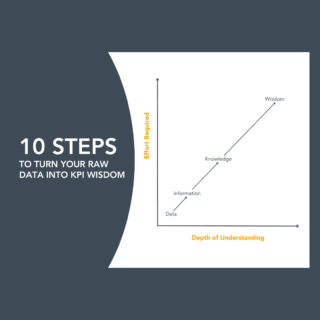Whenever something has power to do tremendous good, there always lurks the ability to use it for significant ill as well. This can be said of performance measurement. But the risks to our organizations are too high to ignore them. Act now with these five ways to mitigate the risks that come from measurement dysfunction and more easily reap the rewards of this powerful management system, when done well.
What exactly is measurement dysfunction anyway?
Measurement dysfunction, as described by Dr. Dean Spitzer, occurs when the measurement process itself, contributes to driving behavior that is not in line, and is often completely opposite to, what is in the best interest of our organization. But there is both a massive threat and a potentially huge opportunity because the process of measurement is within the control and influence of the leadership and managers. However, if no one is taking action to address the evolving dysfunction, things could get dangerous and even illegal.
What makes this situation so dangerous?
Whether you have seen it in the news or witnessed it within organizations you have worked with and for, measures can be manipulated and used in all kinds of dysfunctional ways, including self-promotion, self-protection, and self-benefit.
Sometimes it is a plain lack of know-how that makes leaders invest many hours and dollars into measures that are driven by a system, that itself, is producing little value, but fails to acknowledge it because people are saying, “This is how it is done here”.
With a failure to address the root causes of the problematic parts of your measurement process, the behaviour is perpetuated as individuals believe that it does not appear serious, yet collectively the consequences can be profound.
What do you think causes the biggest problem with measurement?
It all starts with which type of measurement we choose to nurture:
1. Measurement used for Informational purposes means leaders and teams use measurement for learning. In this scenario leaders want to know if their actions are having the intended impact and moving the organization closer to achieving its strategic shift and change. Well-designed measures used for learning, answer this fundamental question: “What is performance doing now, relative to past performance and to future desired performance?”.
2. Measurement used for Motivational purposes: when measures are linked too closely to rewards or threat of punishment, the informational value of measures becomes much less important than trying to induce people into exerting more effort. No matter how many other things are being measured, what is being rewarded becomes the focal point.
When we choose to nurture Measurement for informational purposes, we get the benefits of performance measurement’s tremendous value proposition.
H. James Harrington, author and expert in quality methodologies, says, “Measurement is the first step that leads to control and eventually to improvement. If you can’t measure something, you can’t understand it. If you can’t understand it, you can’t control it. If you can’t control it, you can’t improve it.”
When we choose to use measurement to reward or punish, we get dysfunction that can lead to dangerous business outcomes.
As Steve Jobs of Apple-fame once put it:
“Incentive structures work, so you have to be very careful of what you incent people to do, because various incentive structures create all sorts of consequences that you can’t anticipate.”
Use performance measures as inspiration not intimidation.
Start with avoiding these 5 dysfunctions in your organization’s measurement process.
#1 Avoid putting systems into place that drive self-serving behaviours such as employee of the month, bonus structures for top performers, and job promotions. Rarely does measurement with strong incentives lead to healthy organizational outcomes with sustained improvement because they result in individual motivation vs team motivation.
#2 Avoid using fear to motivate improvement. Fear can be effective at initially driving people to create immediate results, but these early wins produce false hope. The problem is that fearful workplaces become very stressful over time, causing employees to become resentful and develop symptoms of burnout, leading to reduced productivity and silent quitting.
#3 Avoid the temptation to “cheat or game” the system to “look good” because the ramifications of cheating the data are more likely to have the opposite effect in the long run. The reality of what is truly happening within the organization is hidden, creating unnecessary risk and, potentially, even illegal situations.
#4 Avoid the desire to measure everything because it all seems important. Too often measurement becomes an end in itself, disconnected from the larger purpose of the organization and often results in exactly what one manager shared: “We measure too much and get far too little value for what we measure”. Measuring wrong and unnecessary things makes measurement costly, time-consuming, and overwhelming. Focus only on what matters most.
#5 Avoid “suboptimization” which is the practice of focusing on, or making changes to, one component of our workplace, without considering the impact on the whole.You can recognize suboptimization happening when the organization has disparate measurement “silos”. For example, marketing measures, sales measures and operations measures exist in different departments, led by teams attempting to optimize their own numbers, without considering if they are working at cross-purposes with other departments. Usually, the organization overall suffers.
Why are leaders so reluctant to change the measurement system, even when it is delivering little strategic value and costing considerable time and money?
Could it be that they don’t know how? Or because they are deeply invested in the current measurement system and are benefiting from it? Or are they afraid of what might happen if they change it? Try testing it out by posing this question to your leaders and managers: “What if our organization’s performance measurement system delivered tremendous value to leaders’ decision-making during strategy execution? “
Here is how to fix it
With a practical step by step approach which provides your organization with the “how to” needed to avoid falling into these dysfunctions.
Discover more about Performance Measurement here!
Related Article: Fall in love with measurement’s value proposition Part 1 and Part 2
(Special thanks goes to Dean R. Spitzer, PhD, Author of Transforming Performance Measurement, 2007 for his generosity of knowledge and thought within the measurement space and with his permissions with Adura Strategy Inc..)



